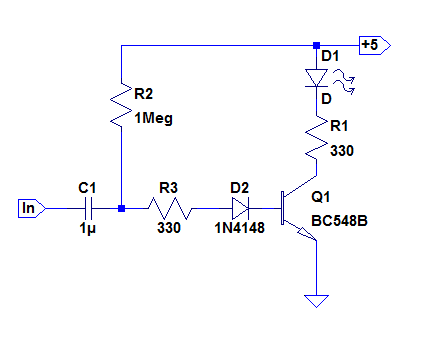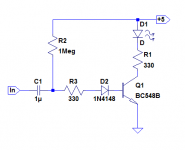Sort of throwing a Hail Mary if anyone has come across a circuit to jazz up the front panel of a piece of equipment? Sort of like a front panel LED that doesn't just stay solid, but pulses to output power, or pulses to music, etc? Thinking that must have been used some time some where on a commercial piece of gear, maybe even just an elegant application of a special purpose IC.
I know you can rig up a simple transistor circuit to act as a single LED to pulse with signal, but doesn't seem like a good solution, as setting would only work at one volume unless there was AGC as well.
I know you can rig up a simple transistor circuit to act as a single LED to pulse with signal, but doesn't seem like a good solution, as setting would only work at one volume unless there was AGC as well.
There are LED VU meter boards available. Some only light one LED at a time,
others light the LED for the current level and also all LEDs below that one.
An example:
VU Meter Level Indicator Amplifier Board Dual Channel 16 LED MCU Adjustable Display Pattern LED Green Color|display meter|display board|display led - AliExpress
others light the LED for the current level and also all LEDs below that one.
An example:
VU Meter Level Indicator Amplifier Board Dual Channel 16 LED MCU Adjustable Display Pattern LED Green Color|display meter|display board|display led - AliExpress
Yes, I've seen those Ray. Those are for sure a good option.
I thought about it some more and did have an idea: a simple opamp-LED-LDR AGC circuit, but with TWO LEDs in parallel, one coupled to the LDR, and the other displayed on the front panel. Kind of high on the parts count though.
I thought about it some more and did have an idea: a simple opamp-LED-LDR AGC circuit, but with TWO LEDs in parallel, one coupled to the LDR, and the other displayed on the front panel. Kind of high on the parts count though.
You could also use a tiny microprocessor. I built a Tubelab SE-II last year that uses the power switch as a status indicator via an Arduino micro. On power-up, the LED stays off for about two seconds while the rest of the amp heats up, then lights steadily to indicate a successful bootup. It also verifies reception of an IR signal when volume "up" or "down" is pressed on the remote. You could do something similar for a "VU" indicator - the possibilities are endless, really.
The only real tradeoffs are having to create a 5V or 3.3V DC source (depending on the model) and learning how to program. It's not for everyone of course, but there are lots of resources out there. Besides given the current circumstances now's as good a time as any to add to one's skill set.
The only real tradeoffs are having to create a 5V or 3.3V DC source (depending on the model) and learning how to program. It's not for everyone of course, but there are lots of resources out there. Besides given the current circumstances now's as good a time as any to add to one's skill set.
You could probably run a peak detector with a slow bleed. Then take the output of that into a 555 timer IC configured as a pulse width modulator.
If the signal levels aren't high enough to modulate the 555, you can always use a voltage doubler or quadrupler as a peak detector. That's only a few more caps and diodes. Or an opamp stage, of course.
Tom
If the signal levels aren't high enough to modulate the 555, you can always use a voltage doubler or quadrupler as a peak detector. That's only a few more caps and diodes. Or an opamp stage, of course.
Tom
From past experience with a "color organ" using light bulbs, the sweet spot to get some sort
of proportional brightness response with the sound is difficult, and varies with each song.
With LEDs you'd want to vary the current, not voltage, so maybe an LM334 could be rigged up.
of proportional brightness response with the sound is difficult, and varies with each song.
With LEDs you'd want to vary the current, not voltage, so maybe an LM334 could be rigged up.
I have made a quick breadboard test of this little circuit, and it seems to work quite satisfactorily:

It operates consistently from very low levels to ~infinity, and can be tweaked on many parameters: for example, R2 sets the quiescent/average brightness, R1 the brightness of the music "flashes", C1 the response of the peak detector.
It is shown with a 5V supply, but it could be adapted for any voltage
It operates consistently from very low levels to ~infinity, and can be tweaked on many parameters: for example, R2 sets the quiescent/average brightness, R1 the brightness of the music "flashes", C1 the response of the peak detector.
It is shown with a 5V supply, but it could be adapted for any voltage
Attachments
In order to avoid low level drop out you could simply use the output to drive a high gain op-amp stage.
This would result in fast almost square wave signal regardless of the signal level.
At least you then have a constant source to play with.
This would result in fast almost square wave signal regardless of the signal level.
At least you then have a constant source to play with.
- Home
- General Interest
- Everything Else
- Looking for a power on LED that does more.
